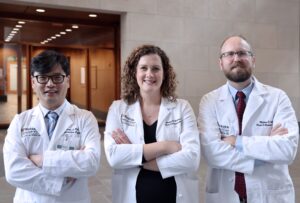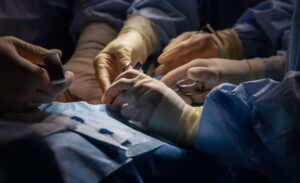Limb Preservation
More than 185,000 people undergo amputation surgeries every year, and more than 2 million people in the U.S. live with limb loss, a statistic expected to double by 2050. At least half of those amputations are the result of vascular disease and complications from conditions such as diabetes, which can lead to non-healing wounds that threaten the health and viability of limbs. Other causes of limb loss include traumatic injury.
Whatever the cause, the loss of a limb can be a devastating event, affecting all aspects of a person’s life. The good news, however, is that physicians specially trained in limb preservation can help many people avoid limb loss. Limb preservation is a multidisciplinary practice within the School of Medicine. Our plastic surgeons work alongside many other world-class Washington University surgeons spanning every medical specialty to provide the best possible care to patients.
Overview
The key to limb preservation is early intervention. Our specialists will quickly assess the injured limb and develop a treatment plan aimed at preservation whenever possible. People at risk due to vascular disease and diabetes can be treated by specialists before they develop non-healing wounds that further compromise their health. And those who experience a traumatic injury and receive treatment from our specialists will benefit from the close collaboration maintained with specialists in other fields of medicine. The goal is to develop a team that can promote healing and prevent limb loss. During the course of care, we will thoroughly discuss all options with you so you can make decisions that are right for you and your family.
Chronic Non-Healing Wounds
Non-healing wounds are open wounds on the body that don’t follow the normal stages of healing, remaining unhealed for at least three months. Left untreated, non-healing wounds will progressively worsen, eventually involving other systems of the body. In severe cases, they can be life-threatening; an untreated, non-healing wound can lead to amputation of the affected limb.
Diabetes is one of several diseases that can affect the flow of blood to the body’s extremities and is often responsible for non-healing wounds, as well as neuropathy, calluses and ulcers. The increase in the number of people living with diabetes in the U.S. has put many limbs at risk of amputation when left untreated.
In addition to diabetes, causes of non-healing wounds include surgical procedures, vascular disease and infection. No matter the cause, limb preservation is most likely to succeed when non-healing wounds are quickly and effectively treated.
Treatment of chronic wounds in people at risk for limb loss is complex. To heal properly, a wound requires oxygen-rich blood. If the body alone can’t supply this, our specialists use a variety of treatments, including: revascularization to help restore blood flow and hyperbaric oxygen therapy, a treatment that uses a pressurized environment to increase the amount of oxygen in the blood.
Traumatic Injury
Many types of traumatic injury require complex reconstructive surgeries to preserve the affected limb. In some situations, specialists can transplant tissue, muscle and nerves from one part of the body to the injured area.
Our reconstructive surgeons are skilled at reattaching severed or nearly severed body parts using a technique called microsurgical replantation. This treatment, performed using microscope magnification, involves reconnecting severed blood vessels, nerves and tissues.
Conditions & Treatments
Our nationally recognized surgeons are dedicated to focusing on your unique limb preservation needs and the following conditions:
- Diabetic ulcers
- Pressure ulcers
- Venous leg ulcers
- Leg ulcers
- Surgical wounds
- Radiation wounds
- Burns and other traumatic injuries of the arms and legs
- Lacerations
Why Choose Us?
The specialists who are part of our Limb Preservation Program are leaders in their field, skilled at using the latest techniques and interventions to preserve limbs whenever possible, whether they are at risk due to disease or trauma.
To help ensure you receive the most effective and efficient treatment possible, this team collaborates with specialists in vascular surgery, podiatry, wound care, infectious disease, nephrology, cardiology, endocrinology and geriatrics, among other specialties. Limb preservation can be a complex process, requiring a variety of specialists to coordinate treatment in the effort to avoid amputation. We also work closely with specialists in rehabilitation, physician therapy and prosthetics.
What to Expect
Once you request an appointment, our scheduling team will call you to schedule your initial consultation. In your first appointment, our limb preservation specialists will perform a tissue assessment to help determine the most effective treatment plan. They will talk with you and any involved family members about the treatment options available, answering your questions and providing the information you need to make decisions that are right for you. As part of your care, our team will coordinate any inpatient or outpatient rehabilitation services you may need.


